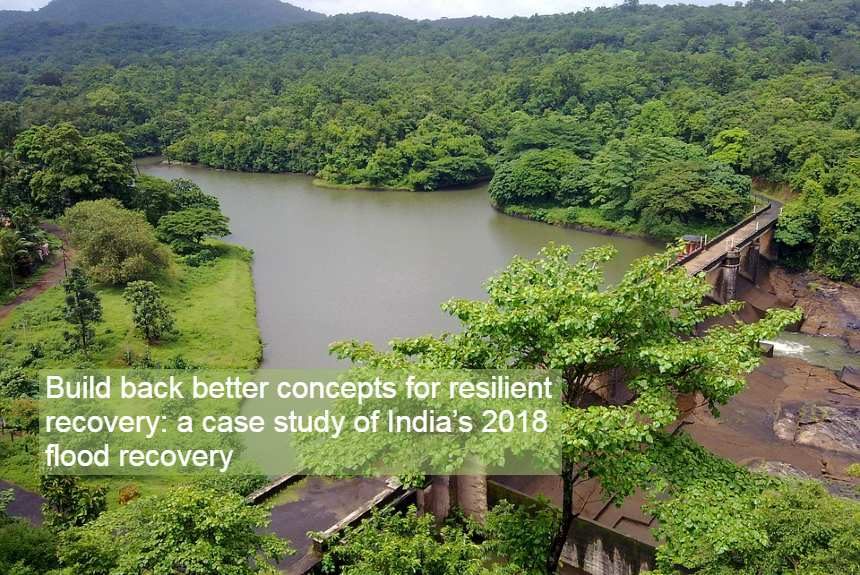Kerala, a state on the southwestern Malabar Coast of India, though one of its most progressive states in social welfare and quality of life, is a highly flood-prone area.
Flood is the state’s most common disaster. From June 2018 to 18th August, the regions received record rainfall – or 164% above average rainfall, resulting in their worst flood experience ever since 1924. Excessive rain caused the area to open its dam that flooded more than one thousand villages.
Three hundred landslides also occurred, which, along with the flood, has killed almost 500 people, displaced more than one million people, and destroyed around 17 thousand km of roads making relief operation difficult.
Over 5 million residents have lost their property and assets, and placed more than 1 million in relief camps, and destroyed.
Following the immediate emergency and relief response after a disaster, the next critical step is the recovery period.
The post-recovery phase involves the following: reconstruction and recovery of infrastructure, properties, business, and essential services, addressing the communities’ psychological and social well-being, addressing pre-disaster weakness in infrastructures and assets, and incorporating resilience rebuilding restoration to ensure that it can withstand against future disasters.
A successful post-recovery will decide the long-term recovery or rehabilitation of a community impacted by disasters.
The study by Shankar Neeraj, Sandeeka Mannakarra, and Suzanne Wilkinson examines the recovery process in Kerala, India, after the community was hit by unprecedented rainfall and flooding in 2018, and the actions done by the government, community, and non-government agencies during this phase.
According to the study, the “Build Back Better (BBB) concept helps create resilience, as it is a holistic approach and focuses on improving the physical, psycho-social and economic conditions of a community through recovery. Resilience refers to “enhancing the ability of a system to anticipate, absorb or recover from a shock and to adapt successfully to such conditions to make the system better and more secure in the future.”
The role of preparedness is also a major component under the UN Disaster Risk Reduction framework during the reconstruction, rehabilitation, and recovery process.
Clinton and Christoplos created the Build Back Better concept in 2006. They consider disasters as opportunities for recovery, reconstruction, and rehabilitation of communities to a better state than before, concepts that were highlighted following the 2004 Indian Ocean Tsunami.
From the BBB concepts, Mannakkara and Wilkinson developed the BBB Framework that applies the concepts of BBB in post-recovery and reconstruction and best practices from references and international case studies.
The BBB framework presents a holistic post-disaster recovery effort through its three dimensions: disaster risk reduction, community recovery, and practical implementation.
The study’s researchers interviewed state government officials, representatives from a Non-Governmental Organisation (NGO), and the United Nations Development Programme (UNDP) – the authorities responsible for delivering the recovery measures to investigate their actions taken.
They also asked residents about the challenges they have encountered and the steps taken to overcome these challenges.
Findings showed that those involved in the post-recovery phase were proactive in helping the community become resilient in future disasters by encouraging residents to rebuild and restore their homes and business and create a local-level recovery authority.
Buildings in the region were built using reinforced concrete, and constructions meet the Indian standard code.
As most houses have 2-stories, people could move to the first floor of the rooftop terrace for safety during floods, and because of the structural ability of the homes to withstand surges, it has reduced the number of casualties.
Nevertheless, there are still some 300 thousand homes affected in varying degrees by floods, and the government has offered a compensations scheme for the repair and rehabilitation of these houses.
Even illegal settlers were also offered government and NGO support to rebuilt their homes. However, some respondents feel that owner-driven rebuilding was a better recovery strategy due to the owner’s involvement in the rebuild.
As for relocation or resettlement, the BBB concept states that this should be considered the last resort. And when opted, a comprehensive resettlement plan and community support should be in place to minimise disruptions.
In Kerala, 619 families decided to relocate to safe zones that the government provided. The government also gave the money to rebuild their homes. The study considered this strategy a good BBB example.
The study also discussed the resident’s level of awareness of disaster risks and vulnerabilities in the area and the steps taken by the government to educate them about the dangers.
There are also some poor practices discovered during the post-recovery phase. Because decisions came from the state level and not from the local or village level, the latter could have had a differing perspective regarding the implementation of recovery actions.
The study also finds that the State Disaster Management Plan (SDMP) of Kerala, a customised plan that identifies the vulnerabilities of the region, measures disaster preparedness, and defines the roles and responsibilities of stakeholders and determines the financial arrangements after a disaster, lacks a comprehensive economic recovery plan, transition strategies and local psychological and social support in the post-recovery efforts of Kerala. These were considered as missed opportunities for further resilience building.
By examining Kerala’s post-flood recovery, the study determined the extent to which Kerala’s post-disaster recovery matched the BBB practices.
The study provided an opportunity to endorse the BBB framework for Kerala to use in their future recovery planning and resilience building.
The study’s findings can also inform disaster recovery actions, especially in building infrastructure resilience to withstand climate-related events and natural disasters.
To read the entire study, click the link below:
Source Citation:
Neeraj, S., Mannakkara, S. and Wilkinson, S. (2020), “Build back better concepts for resilient recovery: a case study of India’s 2018 flood recovery”, International Journal of Disaster Resilience in the Built Environment, Vol. ahead-of-print No. ahead-of-print. https://doi.org/10.1108/IJDRBE-05-2020-0044



Leave a Reply